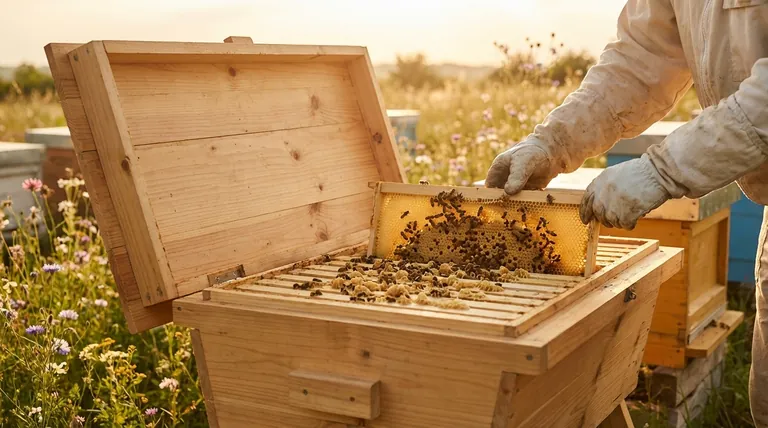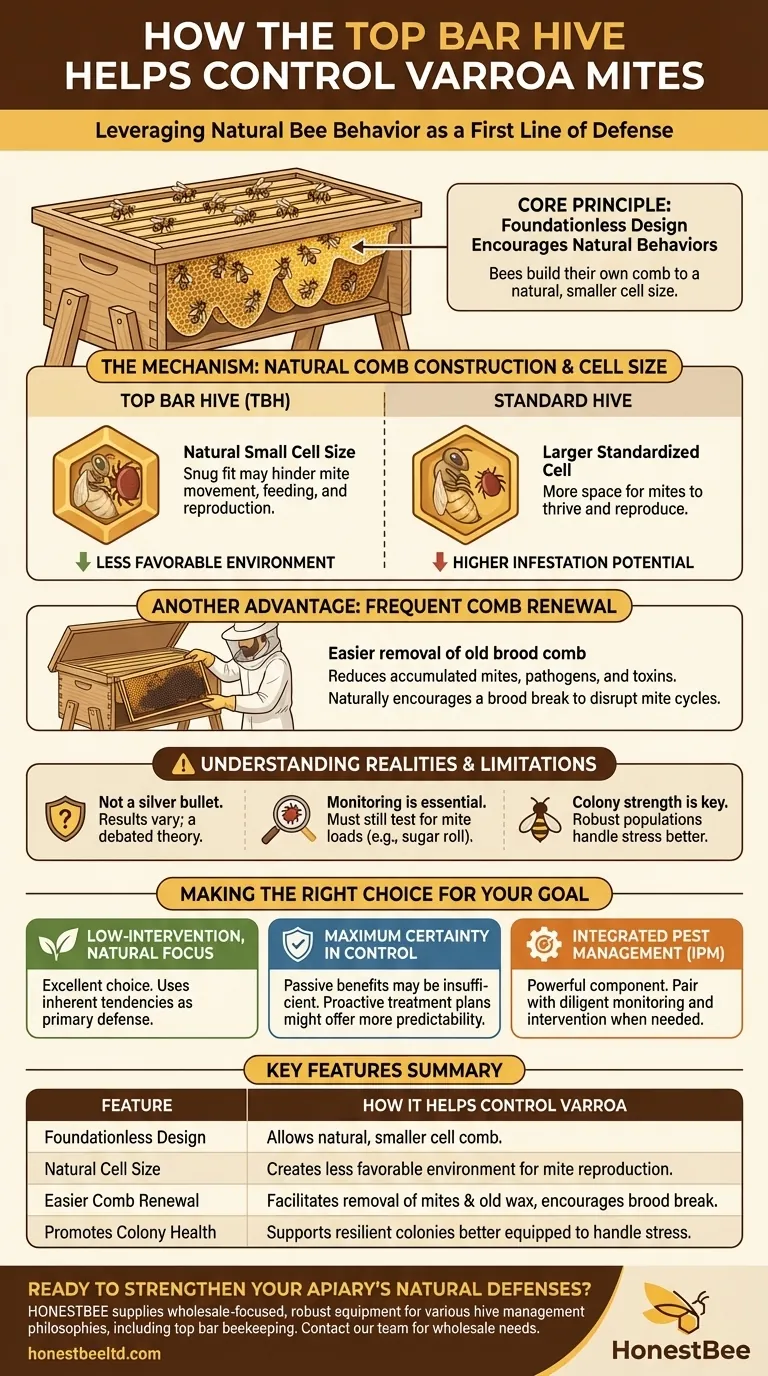At its core, a top bar hive is designed to control varroa mites by encouraging the honeybee colony's natural behaviors. The primary mechanism cited by its proponents is that bees build their own comb to a natural, smaller cell size, which theoretically creates a less favorable environment for the mite's reproductive cycle compared to the larger, standardized cells often found in other hive types.
The top bar hive is not a magic solution for varroa mites, but rather a system that leverages natural bee behavior as a first line of defense. Its effectiveness relies on a holistic management philosophy that sees the hive design as one tool among several for promoting colony health and resilience.

The Core Mechanism: Natural Comb Construction
The central argument for the top bar hive's (TBH) varroa resistance is rooted in how bees build their home. Unlike hives that use pre-made foundation, a TBH is foundationless.
The Natural Cell Size Theory
Advocates propose that when bees are free to build their own comb, they construct smaller hexagonal cells than those typically imprinted on commercial foundation.
This natural cell size is perfectly suited for the developing bee pupa. The theory suggests this snug fit physically constrains the female varroa mite, hindering her ability to move, feed, and successfully reproduce within the capped cell.
How This Differs from Standard Hives
In contrast, many conventional Langstroth hives use plastic or wax foundation with a pre-stamped cell pattern. This pattern is often slightly larger to encourage bees to store more honey and produce larger bees.
This larger cell size is believed to give the varroa mite more space and a better opportunity to thrive and reproduce alongside the developing bee, leading to higher infestation rates.
The Advantage of Frequent Comb Renewal
Because TBHs are foundationless, beekeepers can more easily cycle out old brood comb. Mites, pathogens, and environmental toxins accumulate in old wax.
Regularly removing the oldest combs from the back of the hive is a form of sanitation that directly removes a portion of the mite population and their habitat. This process naturally encourages a brood break in the colony's cycle, another powerful tool for disrupting mite reproduction.
Understanding the Trade-offs and Realities
While the principles are sound, it is crucial to approach this method with a clear understanding of its limitations. The TBH is not a guarantee of a mite-free colony.
A Debated Theory, Not a Silver Bullet
The "small cell size" theory is a well-known concept in natural beekeeping, but it is not universally accepted by the broader scientific community as a definitive solution. Many studies have shown conflicting results.
Mite populations are influenced by many variables, including climate, local mite pressure, and the specific genetics of your bees. Relying on cell size alone is insufficient.
The Necessity of Monitoring
Choosing a top bar hive does not exempt you from your duties as a beekeeper. You must still monitor for varroa mites.
Methods like sugar rolls or alcohol washes are necessary to get an accurate count of your colony's mite load. A "treatment-free" philosophy means avoiding chemical treatments if possible, not avoiding your responsibility to monitor and intervene if the colony's survival is at risk.
Colony Strength is a Major Factor
The reference to swarm prevention highlights a critical point: a strong, populous colony is better equipped to handle any stressor, including varroa mites.
Good management practices that maintain a robust population are just as important as the physical structure of the hive itself.
Making the Right Choice for Your Goal
Ultimately, the top bar hive is a tool that aligns with a specific beekeeping philosophy. Your success with it depends on understanding this context.
- If your primary focus is a low-intervention, natural approach: The top bar hive is an excellent choice, as it uses the colony's inherent tendencies as the primary defense against varroa.
- If your primary focus is maximum certainty in varroa control: Relying solely on the passive benefits of a TBH may be insufficient; a more conventional hive with a proactive and well-timed treatment plan might offer more predictable results.
- If your primary focus is an integrated pest management (IPM) strategy: A top bar hive can be a powerful component, but you must pair it with diligent monitoring and be prepared to take action—like culling drone brood or performing a brood break—if mite levels begin to climb.
Understanding the principles of bee biology and mite life cycles is always more important than the specific equipment you choose.
Summary Table:
| Key Feature | How It Helps Control Varroa Mites |
|---|---|
| Foundationless Design | Allows bees to build natural, smaller cell comb, which may physically hinder mite reproduction. |
| Natural Cell Size | Creates a less favorable environment for varroa mites compared to larger, standardized foundation cells. |
| Easier Comb Renewal | Facilitates regular removal of old brood comb, directly removing mites and encouraging a brood break. |
| Promotes Colony Health | Supports strong, resilient colonies better equipped to handle mite-related stress. |
Ready to strengthen your apiary's natural defenses?
At HONESTBEE, we supply commercial apiaries and beekeeping equipment distributors with the robust, wholesale-focused supplies needed to support a variety of hive management philosophies, including top bar beekeeping. Whether you're expanding your operations or optimizing for colony health, our equipment is built to last.
Contact our team today to discuss your wholesale needs and discover how HONESTBEE can be your reliable partner in sustainable beekeeping.
Visual Guide

Related Products
- Long Langstroth Style Horizontal Top Bar Hive for Wholesale
- Top Bar Beehive for Beekeeping Wholesales Kenya Top Bar Hive
- HONESTBEE Professional Long Handled Hive Tool with Precision Cutting Blade
- HONESTBEE Professional Multi-Functional Hive Tool with Ergonomic Wood Handle
- HONESTBEE Advanced Ergonomic Stainless Steel Hive Tool for Beekeeping
People Also Ask
- What are the most popular types of hives besides the Langstroth? Top Bar & Horizontal Hives Explained
- What are the advantages of a top bar hive? Simpler, Bee-Centric Beekeeping for All
- How does the top bar hive help control varroa mites? A Natural Approach to Mite Management
- What are the benefits of a top bar hive? A Natural, Low-Impact Approach to Beekeeping
- How are entrances designed in top bar hives? Master Beehive Layout for Maximum Honey



















